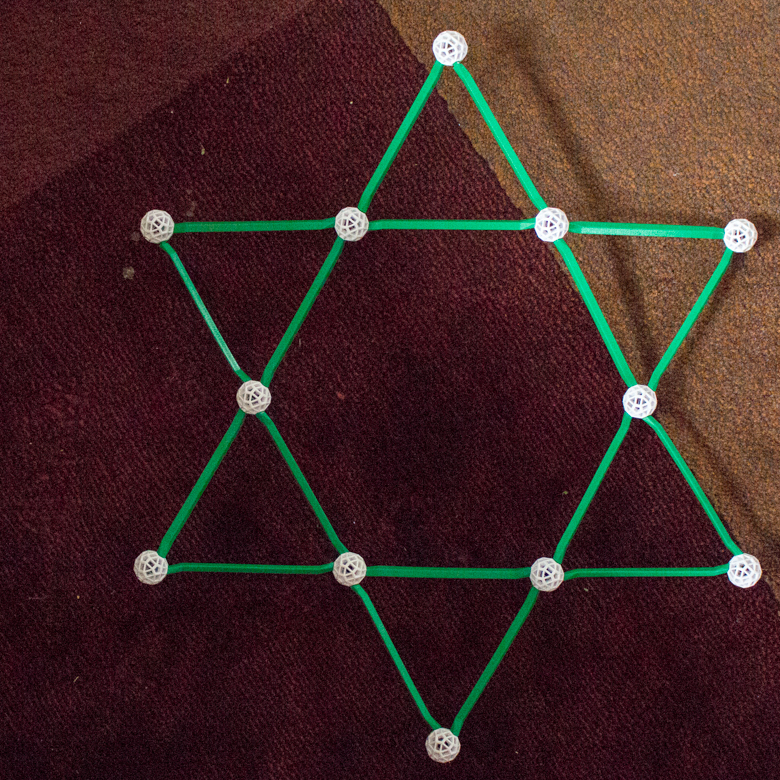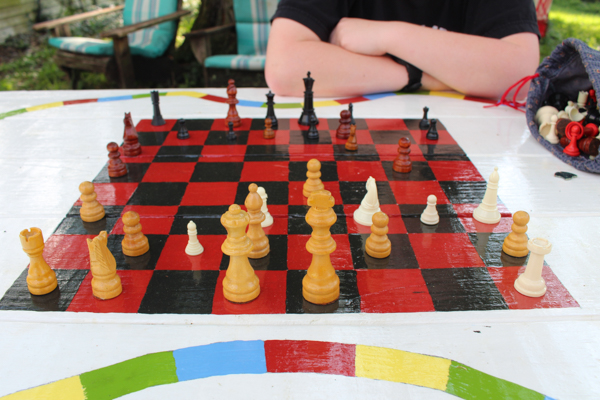.jpg)
Yes, you CAN homeschool math.
Do not give me that sulky face, and don't you dare tell me that you clearly cannot homeschool your child because you obviously don't remember how to divide fractions.
Of course you don't remember some math stuff! You learned all that a zillion years ago! But you know what?
You are a grown-up adult. You can pick it back up. It's really not that big of a deal.
Also, remember that time that you tried to learn some math thing back in school and it was too hard and you got mad at yourself and said that you hated math and you're not good at it?
You were NOT a grown-up adult back then. You were a child.
How fun, then, not to pass that same negative mentality on to your own kids?
Elementary math can be so much fun for kids! Elementary math is fun manipulatives. It's fun games. It's jumping and screaming and singing. It's drawing and painting. It's measuring and pouring. It's reading books together, and doing puzzles, and figuring out interesting problems. It's some of my happiest memories with my kids.
ELEMENTARY MATH
For part of elementary and middle school, we also used this text as a combined math/science/history study:

Here are some other textbook, reading, and viewing resources that we used:
Almost all of these came from the library, and most consist of fun picture books that I found for us to read together--even older elementary kids (and even high schoolers!) love great picture books!
And here are our most important manipulatives:
There are tons more manipulatives that I created myself or Googled, downloaded, and printed. I'm a BIG proponent of DIYing as much as possible!
Below, I've listed tons of the enrichment activities, extra reading/viewing resources, and fun stuff, that I did when my kiddos were elementary ages. They're not listed in any particular order, because they don't have to be done in any particular order! I liked to have the kids doing some kind of hands-on math activity every day, and if it wasn't inspired by them wanting to bake or build or draw or read together, then I invented a fun invitation or set up a game or suggested a project or offered up a puzzle.
I also set up enrichment and hands-on activities to support skills that the kids were struggling with, or to expand on skills that they were blazing through. Seriously, ask me how many hands-on activities I know for teaching rounding!
So scroll through my list of fun enrichment activities, and definitely set them up to support something specific, but also feel free to engage in them at random. I mean, most of what we did in elementary was totally random, and those were some of the best years of my life!
.jpg)
- Building Big Numbers with Base Ten Blocks. This is the BEST math activity that my younger elementary kids ever did. It's endlessly repeatable when they're little, and builds that crucial number sense that they need to make everything else make sense!
- Clock Cake. Clock reading is a skill taught in elementary math, but it's ever more abstract these days, as every device has a digital clock and analogue clocks are becoming more of a rarity. The solution? Bake and decorate your own clock!
- Roll the Time. To get even more clock-reading practice, write minutes onto a blank die, combine it with a twelve-sided die, and have a kid roll the time. She can tell you the answer and draw it onto a blank clock face.
.jpg)
- Demonstrating the Commutative Property of Addition using Cuisenaire Rods. Cuisenaire rods are superb at demonstrating equivalent equations.
- Pascal's Triangle. You can find the blanks for these online, and seconds later, you've got an in-depth addition review!
.jpg)
- Roll to a Hundred. I'd completely forgotten how many of those printable hundred charts we used in the early elementary years! There are endless amounts of games you can make using them, all of which reinforce numeracy and computational skills.
.jpg)
- Add Multi-Digit Numbers using an Abacus. Just as when the kids were learning to read I wanted them to see all kinds of letters in all kinds of fonts and all kinds of sizes and made of all kinds of textures, I liked the kids to practice counting and adding and subtracting in all kinds of ways, with all kinds of manipulatives. If you've never used an abacus, it's well worth learning how to work it properly!
- Write a Googol. Big numbers are so fun for little kids!
- Build Decimal Numbers using Base Ten Blocks. Just as you can build whole numbers with Base Ten blocks, you can also build decimal numbers--it's all Base Ten!
- Subtraction with Borrowing across Zeroes using Base Ten Blocks. If you can do it in Base Ten, you can generally model it with Base Ten blocks.

- Metric Conversions in Grams using Rice Models. If you have a balance scale and some rice, kids can make their own metric conversion models, using a LOT of problem-solving and practical life skills in the process. And even in high school, we STILL pull out those rice models whenever a kid needs a metric conversion refresher!

- Metric Conversions in Liters using Water. You can't keep this metric model forever, but you can use it to cool you off on a hot day!
- Hands-on Rounding. For some reason, Syd really struggled to master this concept, and so now I have a zillion concrete, physical, hands-on ways to teach rounding.
- Decanomial Square. You're going to see me refer to this a lot, as it's one of our most-used math manipulatives. It's well worth DIYing or buying one, because your kids will still be using it in high school!
.jpg)
- Skip Count with Coins on the Hundred Grid. It's good to practice skip counting a lot, and in a lot of different formats. This version also reinforces coin values.
- Multiplication Touch. It's quite the project to build the roll-up hundred mat and the number tiles from scratch, but Multiplication Touch is well worth it! It's surprisingly fun to play, so works great not just for memorizing the facts, but also for reviewing them for years.

- Multi-Digit Multiplication using Area Models. Centimeter graph paper, Base Ten blocks, and Cuisenaire rods are your best friends in elementary!
- Model Long Division with Base Ten Blocks and Cuisenaire Rods. You can cover a LOT of mathematical ground with just those two types of math manipulatives! By the time a kid hits long division, she's already starting to get math instruction that's more focused on teaching her how to plug numbers into an algorithm than it is on understanding what she's doing, and that's not cool with me. When I teach long division, I like to drag out all the blocks and show a kid exactly--and I mean EXACTLY!--what is physically happening to the literal numbers that she's dividing.
- Literally Walk through Long Division. The beauty of homeschooling is that nobody--not you, and definitely not the kids!--are trapped at a desk. Get the wiggles out and bring whole body learning into your math study by drawing a GIANT long-division problem on your driveway and then having your kids solve it. Who knew there was so much walking, crawling, and skipping in math?
- Compose Fractions with Rice Krispy Treat Models. Because number sense is delicious!
- Model Converting Mixed Fractions to Improper Fractions. You need circle fraction manipulatives for this activity, but the good news is that it makes converting between mixed fractions and improper fractions as clear as a bell and as easy as pie! Here are the circle fraction manipulatives that we own:
- Level these fraction models up to middle school and high school by bringing them out whenever kids need a review. They WILL randomly forget how to convert between mixed and improper fractions, but going back to the manipulatives will quickly remind them, and every time they re-learn it, they'll cement it into their brains even better!
- Montessori Pink Tower. Playing with the Pink Tower can be soooooo satisfying for the pattern-loving child, and it's great for their hand-eye coordination and number sense.
- Montessori Pink Tower and Cuisenaire Rod Patterns. If you're loving the idea of open-ended exploration of math manipulatives for young learners, then you should really check out Montessori math! These kid-built, elaborate patterns are satisfying to create and look at, and since they're built on a Base Ten system at a centimeter scale, they're terrific for building a kid's number sense. Here's the Montessori Pink Tower:

- Level pattern-building using the Montessori Pink Tower and Cuisenaire rods to middle school by having kids create their own diagrams or pattern cards from their creations. Perhaps they want to share them with a younger learner, or even publish them!
.jpg)
- Blow Bubbles with Geometric Figures. What happens inside a prism when you dunk it into bubble solution? More fascinating geometrical models! Here are our Zometools:
- Find the Area of Irregular Polygons using Graph Paper. Everything is more fun when it's on graph paper! For even more reinforcement, use centimeter graph paper and fill in the polygons with Base Ten hundreds, tens, and ones, and Cuisenaire rods.

- Make Mandalas with a Compass and Protractor. Here's a fun art activity that happens to teach compass and protractor use while also offering a lot of scope for creativity and process-oriented art.
- Level this activity up for middle and high school by encouraging even more elaborate, thoughtful creations.
- Origami. This is one of the best geometry activities that your kids won't even recognize as math work! Start with SUPER simple builds so that they don't get frustrated with the fine motor requirements, but no matter what they make, they're building an intrinsic knowledge of angles and shapes and how they work together in two- and three-dimensional spaces.
- Level this up to middle school and high school by working through ever-more-challenging how-to books.
- Pentominoes. Allowing kids free exploration of mathematical models and manipulatives and interesting shape puzzles is one of the best things that you can do with them in elementary, whether or not you're officially homeschooling. Pentominoes are especially fun for older elementary kids who enjoy stretching themselves with challenging puzzles.
- Level pentominoes up to middle school and high school by working through ever-more-challenging puzzles, and calculating the number of possible solutions to puzzles.
- Ink Blot Prints that Show Bilateral Symmetry. Get really messy in order to get really symmetrical!
- Symmetry and Similar Figures with Pattern Blocks. This is a more challenging activity for older elementary, but you get to drag out ALL the pattern blocks and it makes the kinda abstract concept of similar figures crystal clear!
- Tangrams. This is another math manipulative that's endlessly entertaining, even onto middle school and high school. Heck, *I* still love to play with tangrams!
- Zometool Stellations. To stellate a polygon is to extend its line segments. It always makes something beautiful, and it encourages kids to stretch their imaginations and become more mathematically creative thinkers.
- To level this to middle school, have the kids measure the angles both inside and outside their polygons.








































